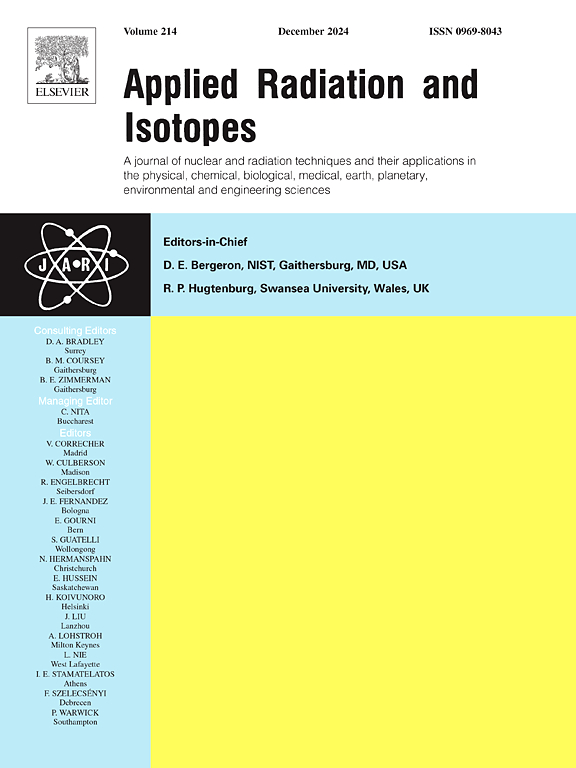Estimating Uncertainty in Actinide Intake Due to Unknown Time of Exposure
IF 1.6
3区 工程技术
Q3 CHEMISTRY, INORGANIC & NUCLEAR
引用次数: 0
Abstract
Bioassay of radiation workers handling actinides in powder form is carried out annually under routine monitoring program. In case of routine monitoring, as the day of intake is unknown, it is assumed that intake has occurred at the midpoint of monitoring interval. However, an uncertainty is introduced in intake estimation due to this assumption. In the present work, uncertainties were evaluated due to unknown time of intake of Type M and S compounds of Pu and U for annual and biennial monitoring interval. Lung and excreta monitoring methods were considered for uncertainty estimation along with the spread of ±1 month or ±2 months in measurements, at the end of monitoring interval. Annual lung monitoring is found to be the most robust and accurate method for assessment of intake of Type S compounds of Pu, Am and U when time of intake is unknown and Pu is detected using 241Am as a tracer. For Type M compounds, uncertainty was found to be higher than 3 for biennial monitoring interval. Uncertainty is found to be less than 3 for Type S compounds of Pu and U and also for Type M compounds of Pu for both, annual and biennial monitoring intervals using urine analysis. It is higher than 3 for Type M compounds of U for both the monitoring intervals. It is greater than 3 for both Type M and S compounds of Pu and U for both the monitoring intervals using fecal analysis.
估算因暴露时间未知而导致的锕系元素摄入量的不确定性。
在例行监测计划下,每年都会对处理粉末状锕系元素的辐射工作人员进行生物测定。在例行监测中,由于摄入日不详,因此假定摄入发生在监测间隔的中点。然而,由于这一假设,在摄入量估算中引入了不确定性。在本研究中,由于每年和每两年监测一次钚和铀的 M 型和 S 型化合物的未知摄入时间,对不确定性进行了评估。在估算不确定性时,考虑了肺和排泄物监测方法以及监测间隔结束时测量值的±1 个月或 ±2 个月的差值。当摄入时间未知,并使用 241Am 作为示踪剂检测钚时,发现年度肺监测是评估钚、镅和铀的 S 类化合物摄入量的最可靠、最准确的方法。就 M 类化合物而言,两年监测一次的不确定性大于 3。对于钚和铀的 S 类化合物以及钚的 M 类化合物,在使用尿液分析进行年度和双年度监测时,不确定性均小于 3。在两个监测周期内,M 类 U 化合物的不确定性均大于 3。利用粪便分析法,在两个监测周期内,钚和铀的 M 型和 S 型化合物的含量均大于 3。
本文章由计算机程序翻译,如有差异,请以英文原文为准。
求助全文
约1分钟内获得全文
求助全文
来源期刊

Applied Radiation and Isotopes
工程技术-核科学技术
CiteScore
3.00
自引率
12.50%
发文量
406
审稿时长
13.5 months
期刊介绍:
Applied Radiation and Isotopes provides a high quality medium for the publication of substantial, original and scientific and technological papers on the development and peaceful application of nuclear, radiation and radionuclide techniques in chemistry, physics, biochemistry, biology, medicine, security, engineering and in the earth, planetary and environmental sciences, all including dosimetry. Nuclear techniques are defined in the broadest sense and both experimental and theoretical papers are welcome. They include the development and use of α- and β-particles, X-rays and γ-rays, neutrons and other nuclear particles and radiations from all sources, including radionuclides, synchrotron sources, cyclotrons and reactors and from the natural environment.
The journal aims to publish papers with significance to an international audience, containing substantial novelty and scientific impact. The Editors reserve the rights to reject, with or without external review, papers that do not meet these criteria.
Papers dealing with radiation processing, i.e., where radiation is used to bring about a biological, chemical or physical change in a material, should be directed to our sister journal Radiation Physics and Chemistry.
 求助内容:
求助内容: 应助结果提醒方式:
应助结果提醒方式:


